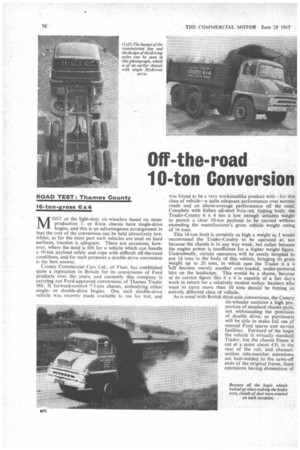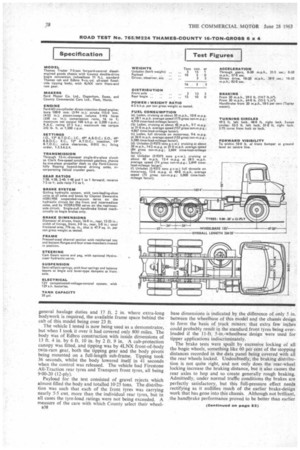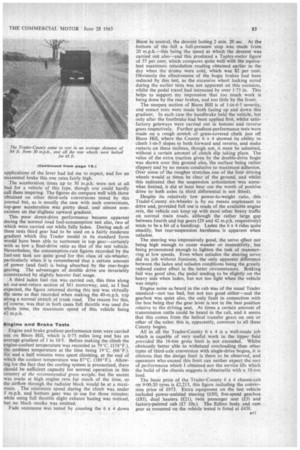Off-the-road 10-ton Conversion
Page 78

Page 79

Page 80

Page 85

If you've noticed an error in this article please click here to report it so we can fix it.
MOST of the light-duty six-wheelers based on massproduction 7or 8-ton chassis have single-drive bogies, and this is an advantageous arrangement in that the cost of the conversion can be held attractively low, whilst, as for the most part such vehicles are used on hard surfaces, traction is adequate. There are occasions, however, where the need is felt for a vehicle which can handle a 10-ton payload safely and cope with difficult off-the-road conditions, and for such purposes a double-drive conversion is the best answer.
County Commercial Cars Ltd., of Fleet, has established quite a reputation in Britain for its conversions of Ford products over the years, and currently this company is carrying out Ford-approved conversions of Thames Trader Mk. II forward-control 7.5-ton chassis, embodying either single— or double-drive bogies. One such double-drive vehicle was recently made available to me for test, and was found to be a very workmanlike product with—for this class of vehicle—a quite adequate performance over normal roads and an above-average performance off the road. Complete with Edbro all-steel 9-cu.-yd. tipping body, the, Trader-County 6 x 4 has a low enough unladen weight to permit a clear 10-ton payload to be carried without exceeding the manufacturer's gross vehicle weight rating of 16 tons.
This 16-ton limit is certainly as high a weight as I would recommend the Trader-County to be operated at, not because the chassis is in any way weak, but rather because the engine power is insufficient for a higher weight figure. Undoubtedly, certain operators will be sorely tempted to put lit tons in the body of this vehicle, bringing its gross weight up to 20 tons, in which case the Trader 6 x 4 -will become merely another over-loaded, under-powered blot on the landscape. This would be a shame, because at its correct figure this 6 x 4 is capable of a fair day's. work in return for a relatively modest outlay: hauliers who want to carry more than 10 tons should be buying an entirely different class of vehicle.
As is usual with British third-axle conversions, the County six-wheeler contains a high proportion of standard chassis parts, not withstanding the provision of double drive, so purchasers will be able to make full use of normal Ford spares and service facilities. Forward of the bogie the vehicle is virtually standard Trader, but the chassis frame is cut at a point about 4 ft. to the rear of the cab, and channelsection side-member extensions are butt-welded to the sawn-off ends of the original frame, these extensions having dimensions of 9-5 in. by 2.94 in. by 0.276 in. Additional reinforcing is provided at the joins by diamond-shaped flitch plates welded to the insides of the channels, whilst bogie-suspension forces are accommodated by channel-section boxing members inserted into the main channels in the vicinity of the bogie centre line.
To ensure really adequate frame strength, 2.5 in. by 0.25 in. reinforcing strips are stitch-welded to the top and bottom flanges of the side members, the upper strip starting 9 in. ahead of the cab rear, but the lower strip starting at the front-axle centre line, and both extending to the extreme rear of the frame. Cross-members, hanger brackets and so forth are riveted in place.
Although the standard Trader front springs are retained, four heavy-duty 3-in.-wide non-standard springs with a rate of 3,800 lb./in. are used at the bogie, these having rubberbushed eyes to eliminate the need for lubrication. The springs are linked by symmetrical balance beams carried on taper-roller bearings at the ends of a transverse crosstube, and the double-drive bogie with 9.00-20 tyres has an articulation of 7 in., this figure being 8.5 in. in the case of the single-drive bogie with 8.25-20 equipment.
The driving axles are manufactured by County but are, to a certain extent, based on the Trader design and incorporate standard Trader differential assemblies, halfshafts, hubs, brakes and drums. The banjo also is standard, but reinforcing rings are welded at front and rear to accommodate the special gearing. Standard crown wheels are employed, but the pinions differ in having longer shafts. The nose of the leading axle carries a helical gear train, the lower gear being carried on the pinion shaft so that the drive to the crown wheel is taken direct from the propeller shaft. The upper gear drives a shaft which passes through the axle banjo, running alongside the crown wheel, and the
rear end of this shaft carries the companion flange for the short universally-jointed inter-axle drive shaft. The second axle is identical to the leading axle, but it is used the other way round so that the two axles are mounted back-to-back. The standard final-drive ratio is 7-2 to I, and the combined load capacity of the bogie is 32,000 lb. The additional weight incurred by this bogie when compared with the single-drive assembly is 5-5 cwt. The braking system. of this model has been the subject of a certain amount of research over the past few years. The original Trader-County 6 x 4 introduced at the end of 1959 had a single Clayton Dewandre upright-vacuum servo, but about ten months later this was replaced by a single Hydrovac suspended vacuum servo. As an experimental project, one of these vehicles was equipped with Westinghouse air-pressure braking assistance, this machine having been demonstrated by County at the Commercial Motor Show last September, but within the last three months the braking system has been finalized with two Clayton Dewandre Hydrovacs.
One of these is the standard Trader servo boosting the hydraulic circuit for the front and second axles, and alongside this is a slightly smaller Hydrovac powering the thirdaxle brakes. The action of the secondary servo is controlled by the primary servo, and in effect this system can be termed "split circuit" except that in the event of vacuum failure the main master cylinder is effective on the frontand second-axle brakes only. The handbrake lever—again standard Trader—is linked by a system of rods and compensating levers to both axles. Now that air-hydraulic brakes are offered on Trader chassis, the County 6 x 4 will obviously be available with this equipment in place of the standard Hydrovacs.
Petroland diesel-engined versions of the Trader-County 6 x 4 are offered, although, as might be expected, hardly any petrol versions are demanded these days, and the Ford four-speed synchromesh gearbox is standard. The Clark five-speed synchromesh gearbox, as available on certain Thames models, is offered in either director overdrive-top versions, whilst there is the further option of the David Brown 552 five-speed constant-mesh box, which has a considerably lower bottom gear than the Clark assembly fitted in the vehicle tested, this Clark box in turn giving a decidedly better gradient potential than the Ford four-speed box.
Both 6 x 2 and 6 x 4 versions are available with a choice of five wheelbases: 11 ft. (as tested) for tipper applications, 11 ft. Sin, for truck mixers, 13 ft. 4 in. and 15 ft. 2 in. for general haulage duties and 17 ft. 2 in. where extra-long bodywork is required, the available frame space behind the cab of this model being over 23 ft.
The vehicle I tested is now being used as a demonstrator, but when I took it over it had covered only 800 miles. The body was of Edbro construction with inside dimensions of 13 ft. 4 in. by 6 ft. 10 in. by 2 ft. 9 in. A cab-protection canopy was fitted, and tipping was by 4LNX front-of-body twin-ram gear, both the tipping gear and the body pivots being mounted on a full-length sub-frame. Tipping took 36 seconds, whilst the body lowered itself in 41 seconds when the control was released. The vehicle had Firestone All-Traction rear tyres and Transport front tyres, all being 9-00-20 (12-ply).
Payload for the test consisted of gravel rejects which almost filled the body and totalled 10.25 tons. The distribution was such that each of the front tyres was carrying nearly 5.5 cwt. more than the individual rear tyres, but in all cases the tyre-load ratings were not being exceeded. A measure of the care with which County select their wheel B38 base dimensions is indicated by the difference of only 5 in. between the wheelbase of this model and the chassis design to form the basis of truck mixers: that extra few inches could probably result in the standard front tyres being overloaded if the 11-ft. 5-in.-wheelbase design were used for tipper applications indiscriminately.
The brake tests were spoilt by excessive locking of all the bogie wheels, something like 60 per cent of the stopping distances recorded in the data panel being covered with all the rear wheels locked. Undoubtedly, the braking distribution is not quite right, and not only does the rear-wheel locking increase the braking distance, but it also causes the rear axles to hop and so create generally rough braking. Admittedly, under normal traffic conditions the brakes are perfectly satisfactory, but this full-pressure effect needs rectifying as it nullifies much of the earlier brake-design work that has gone into this chassis. Although not brilliant, the handbrake performance proved to be better than earlier applications of the lever had led me to expect, and for an unassisted brake this one rates fairly high.
The acceleration times up to 30 m.p.h. were not at all bad for a vehicle of this type, though one could hardly call them inspiring. The figures do compare well with those obtained on other third-axle conversions tested by this journal but, as is usually the case with such conversions, top-gear acceleration was pretty dead, and almost nonexistent on the slightest upward gradient.
This poor direct-drive performance became apparent during the normal road fuel-consumption test also, two of which were carried out while fully laden. During each of these tests third gear had to be used on a fairly moderate gradient which this Trader model in its standard form would have been able to surmount in top gear—certainly with as low a final-drive ratio as that of the test vehicle. Nevertheless, the consumption-rate figures recorded by the fuel-test tank are quite good for this class of six-wheeler, particularly when it is remembered that a certain amount of power (and fuel) is being absorbed by the rear-bogie gearing. The advantages of double drive are invariably counteracted by slightly heavier fuel usage.
A third laden fuel run was carried out, this time along an out-and-return section of Ml motorway, and, as I had expected, the figure returned during this test was virtually the same as that recorded when making the 40-m.p.h. trip along a normal stretch of trunk road. The reason for this, of course, was that in both cases full throttle was used the whole time, the maximum speed of this vehicle being 42 m.p.h.
Engine and Brake Tests
Engine and brake gradient-performance tests were carried out on Bison Hill, which is 0.75 miles long and has an average gradient of 1 in 10.5. Before making the climb the engine-coolant temperature was recorded as 79C. (174°F.), the ambient temperature at the time being I9°C. (66°F.). Six and a half minutes were spent climbing, at the end of which the coolant temperature was 87°C. (189°F.). Allowing for the fact that the cooling system is pressurized, there should be sufficient capacity for normal operation in this country at the recommended gross weight, but the ascent was made at high engine revs for much of the time, so the airflow through the radiator block would be at a maximum. The minimum speed during the climb was under 5 m.p.h. and bottom gear was in use for three minutes: while using full throttle slight exhaust hazing was noticed, but no black smoke was emitted.
Fade resistance was tested by coasting the 6 x 4 down Bison in neutral, the descent lasting 2 min. 20 sec. At the bottom of the hill a full-pressure stop was made from 20 mph—this being the speed at which the descent was carried out also—and this produced a Tapley-meter figure of 57 per cent, which compares quite well with the equivalent maximum retardation reading obtained earlier in the day when the drums were cold, which was 82 per cent. Obviously the effectiveness of the bogie brakes had been reduced by this test, as the excessive wheel locking noted during the earlier tests was not apparent on this occasion, whilst the pedal travel had increased by over 1.75 in. This helps to support my impression that too much work is being done by the rear brakes, and too little by the front.
The steepest section of Bison Hill is of 1-in-6.5 severity, and restart tests were made both facing up and down this gradient. In each case the handbrake held the vehicle, but only after the footbrake had been applied first, whilst satisfactory getaways were carried out in bottom and reverse gears respectively. Further gradient-performance tests were made on a rough stretch of grass-covered chalk just off Bison Hill, where the County 6 x 4 showed its ability to climb I-in-5 slopes in both forward and reverse, and make restarts on these inclines, though not, it must be admitted, without a certain amount of clutch slip taking place. The value of the extra traction given by the double-drive bogie was shown over this ground also, the surface being rather slippery and by no means conducive to maximum adhesion. Over some of the rougher stretches one of the four driving wheels would at times be clear of the ground, and whilst this indicated that the suspension articulation was somewhat limited, it did at least bear out the worth of positive drive to both axles (a third differential is not fitted).
Despite its relatively low power-to-weight ratio, this Trader-County six-wheeler is by no means unpleasant to drive and, provided full use is made of the available engine revs, the vehicle can keep up with most other heavy traffic on normal main roads, although the rather large gap between fourth and top gears (29 and 42 m.p.h. respectively) tends to be a bit of a handicap. Laden the 6 x 4 rides quite steadily, but rear-suspension harshness is apparent when unladen.
The steering was impressively good, the servo affect not being high enough to cause wander or insensitivity, but being pronounced enough to lighten the task of rnanceuvring at low speeds. Even when unladen the steering servo did its job without fussiness, the only apparent difference between the laden and unladen conditions being the greatly reduced castor effect in the latter circumstances. Braking feel was good also, the pedal tending to be slightly on the heavy side when laden, but not too light when the vehicle was empty. '
Engine noise as heard in the cab was of the usual Trader standard—not too bad, but not too good either—and the gearbox was quiet also, the only fault in connection with the box being that the gear lever is not in the best position relative to the driving seat. At times a certain amount of transmission rattle could be heard in the cab, and it seems that this comes from the helical transfer gears on one or other of the axles: this is, apparently, common to all these County bogies.
All in all the Trader-County 6 x 4 is a well-made job which is capable of very useful work in the tipper field provided the I6-ton gross limit is not exceeded. Whilst obviously better able to withstand overloading than other types of third-axle conversion with single-drive bogies, it is obvious that the design limit is there to be observed, and operators who exceed this limit can neither expect the sort of performance which I obtained nor the service life which the build of the chassis suggests is obtainable with a 10-ton load.
The basic price of the Trader-County 6 x 4 chassis-cab on 9-00-20 tyres is £2,213, this figure including the conversion price of £973. Extra equipment on the test vehicle included power-assisted steering (£50), five-speed gearbox (£85), dual heaters (no, twin passenger seat (£5) and factory-painted cab (£7 10s.). The Edbro body and ram gear as mounted on the vehicle tested is listed at £438.












































































































































